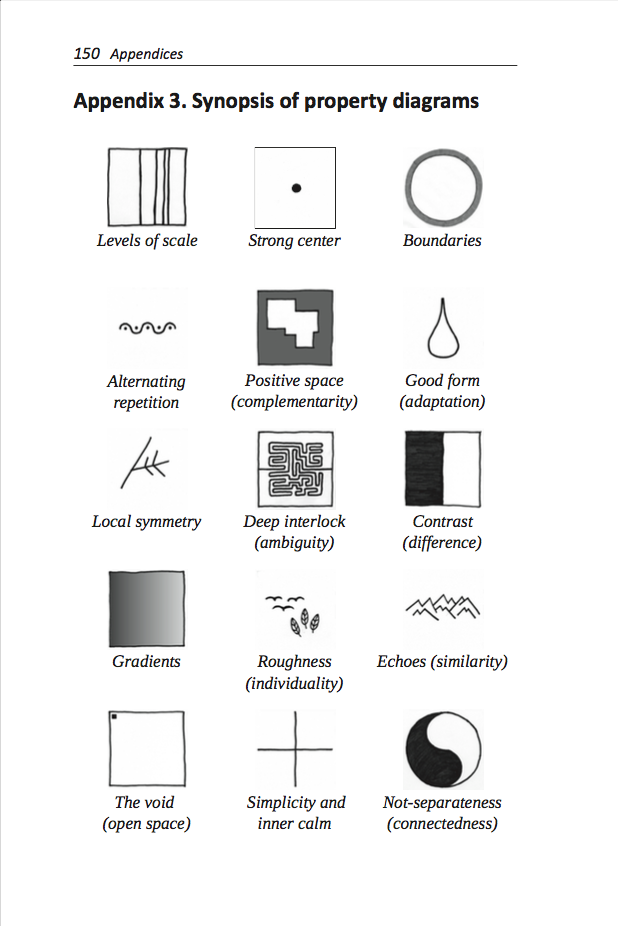
| |
» | |
| Pattern Theory | Changes Search Index Preferences Edit |
|
Pattern Theory Book Christopher Alexander Additional Resources The Banner Icons Contact Me
|
The Banner Icons
The icons in the banner image of this wiki represent the 15 properties of living systems which Christopher Alexander has described in his book The Phenomenon of Life, the first of the four volumes of The Nature of Ordner. These 15 properties are one of Alexander's major achievements, and many people know them, but – this is important to understand – they are just a minor part – maybe 20% – of Alexander's way of thinking. In that sense the banner and its icons do not represent the whole content of the book, but only a part, and act here primarily as a convenient eyecatcher. I've drawn these icons in the year 2007 after I wrote the original German version of the Pattern Theory Book when I saw that even the reduction from 4000 pages of original texts to 160 pages of my little book was not enough to bridge the distance to a lecture's audience. Therefore I started to create such visualizations: to pack Alexander's ideas in even smaller space, and to make them stick in mind. The icons were first shown at the "Structure - Process - Patterns" Symposium at the Technical University of Vienna, 12 June 2007. The symposium was hosted by professor Christian Kühn, who had visited the Eishin Campus near Tokyo for a direct experience of Alexander's architecture. Nikos Salingaros, the editor of The Nature of Order, gave a lecture about "Patterns in Architecture", and I talked about "Patterns Beyond Architecture". Nikos, who has become a friend since then, was so friendly to publish the icons in some of his books – a big honor for me. Finally, I published them myself in the Pattern Theory Book. There are small sections for each of the properties, each less than a page in size. Over time, when using the properties in various application domains, I found that some of Alexander's properties can become clearer using the periphrases that I've added in parentheses.
In my view, these properties are categories of form, and probably part of our cognitive system, similar to Kant's a priori of space and time. I think the fifteen properties put Alexander in a group with Aristotle and Kant regarding the fundamentals of our thinking. The fifteen properties can fill various roles, for example: (1) they can help us with our perceptions, to let us see things that we otherwise wouldn't see. (2) They can help us analyze systems and communicate our views. (3) We can use them as dimensions of development to think about changing a system to embody more or less of each of the properties.
Chapter 11 "Alexander’s Fifteen Fundamental Properties" of the book Unified Architectural Theory by Nikos Salingaros published online
1) (easy) Try to identify the most important concept of this page. The concept that I clearly show in the center of Alexander's way of thinking, although it is not emphasized at all, and mentioned only once.
Contact Me if you are able to identify it.
2) (medium) The fifteen property are not independent, not unconnected. Each property is typically related to 4-8 of other properties in the sense of "A implies B". Create a table and try to identify these relationships. Alexander's solution to this question (91 relationships) is both in The Nature of Order (volume 1) and in the appendix of the Pattern Theory Book.
An 80 % agreement would be a good result.
3) (difficult) There are at least three meta-concepts – higher level concepts – hidden in these properties. You will probably not able to recognize them without studying Alexander's principles of living processes, maybe his whole work.
Contact Me if you recognize them – maybe you see more than I see.
|
| © Helmut Leitner | changed: October 13, 2015 |
